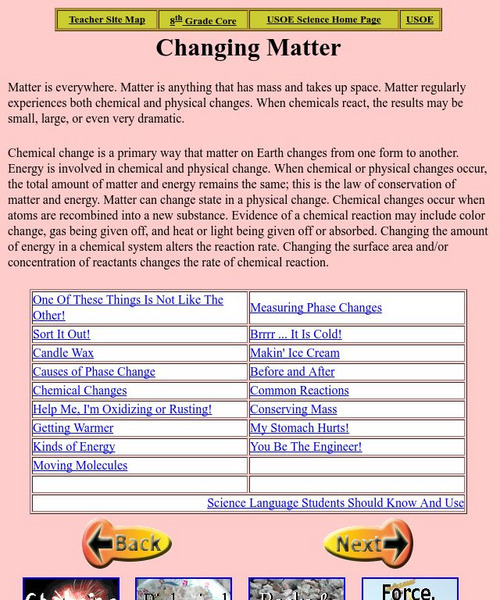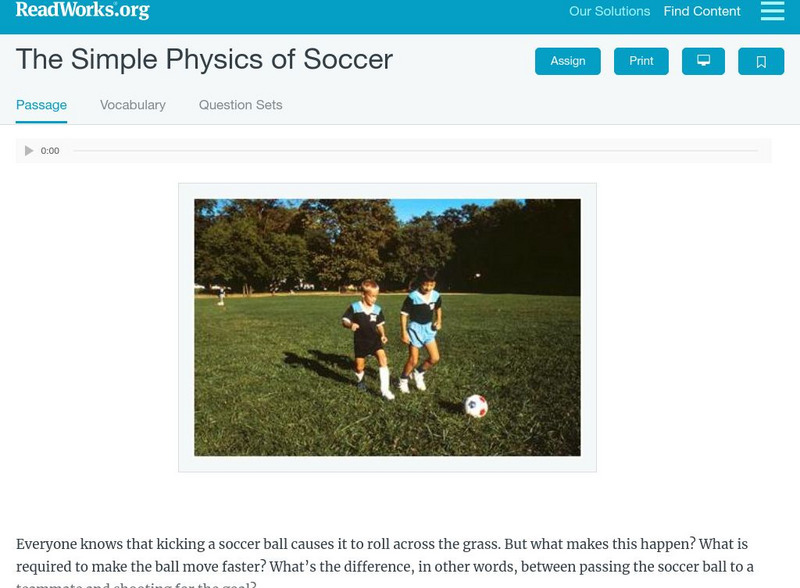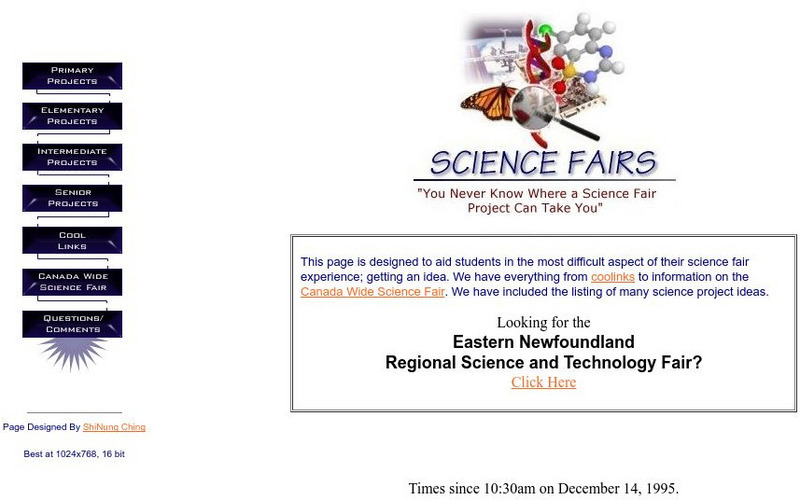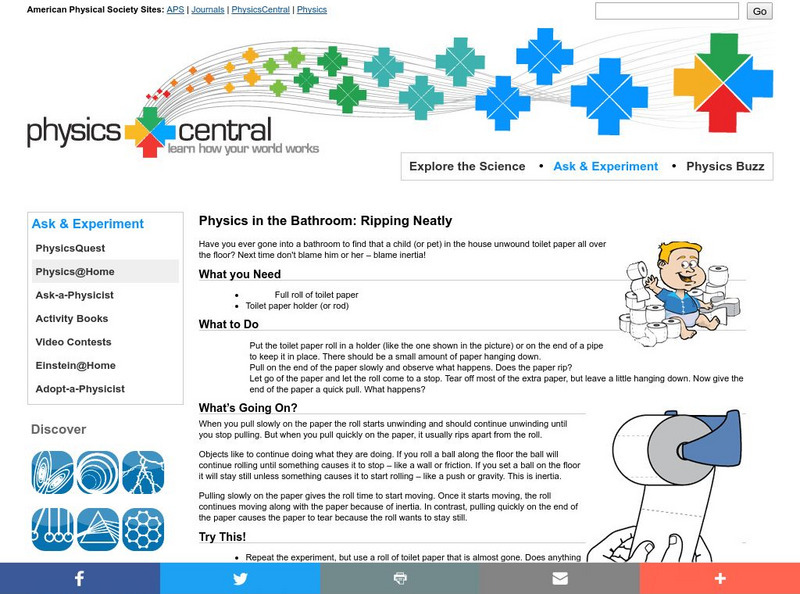Utah State Office of Education
Utah Science: Changing Matter
Matter changes both physically and chemically on a fairly regular basis. Through these activities students will challenge their understanding of the changes that may take place with different types of matter.
Read Works
Read Works: The Simple Physics of Soccer
[Free Registration/Login Required] An informational text explaining the physics behind soccer. A question sheet is available to help students build skills in reading comprehension.
Read Works
Read Works: The Science of Fun!
[Free Registration/Login Required] An informational text about the science behind circus acts. A question sheet is available to help students build skills in reading comprehension.
BBC
Bbc Schools: Ks2 Bitesize: Science: Materials: Changes in Materials
Help solve the mystery and find the missing crystal. Following the activity, read more about chemical and physical changes, and then take a quick quiz to check for understanding.
Other
Cdli: Science Fairs Homepage
At this site from the Center for Distance Learning and Innovation there's a monstrous listing of possible science fair projects. You can choose from primary (grades 1-4), elementary (grades 4-6), intermediate (grades 7-9), or senior...
Scholastic
Scholastic: Study Jams! Science: Animals: Animal Adaptations
A video and a short multiple-choice quiz on the topic of animal adaptations, that look at physical and behavioral adaptations.
United Nations
Unesco: Science Test Questions (In Arabic)
Part of a larger site on math and science education. This page has over thirty-five multiple -choice and short-answer questions for 3rd and 4th grade science. Questions ask students to define terms (e.g., in Physics, Biology) or use...
E-learning for Kids
E Learning for Kids: Science: Loch Ness: What Properties Do Materials Have?
This lesson looks at how the physical properties of materials determine how they can be used, and students decide which materials are strong, hard, soft, or transparent.
Maryland Science Center
Maryland Science Center: Create a Kitchen Chemistry Kit [Pdf]
Instructions for how to safely create a chemistry set using basic ingredients found around the home. Provides two experiments to try, one involving a physical change and the other a chemical change.
Maryland Science Center
Maryland Science Center: Field Goal! [Pdf]
Create a catapult using the provided link, then experiment with it to see how your accuracy at making a field goal is affected by distance from the goal posts. Learn about the physics of the football's trajectory path.
Physics Central
Physics Central: Physics in the Bathroom: Ripping Neatly
A great science experiment to demonstrate Newton's First Law of Motion, inertia. There is a step-by-step guide on how to conduct this experiment and links to other sites about inertia.
Scholastic
Scholastic: Study Jams! Science: Weathering & Erosion
A video and a short multiple-choice quiz on the topic of weathering and erosion, what they are, and how they alter the Earth's surface.
Ducksters
Ducksters: Physics for Kids: Kinetic Energy
Kids learn about kinetic energy in the science of physics. The energy of motion can be calculated using mass and velocity. The standard unit is the joule. How it is different from potential energy.
Ducksters
Ducksters: Physics for Kids: Lenses and Light
Kids learn about lenses and light in the science of physics including concave, convex, converging, diverging, focal point, meniscus, and Plano lenses.
Ducksters
Ducksters: Physics for Kids: Mass and Weight
Kids learn about mass and weight in the science of physics and the laws of motion including units and measurement. What is the difference between mass and weight?
Ducksters
Ducksters: Physics for Kids: Momentum and Collisions
Kids learn about momentum and collisions in the science of physics and the laws of motion including units and measurement. Calculate momentum using mass times velocity.
Ducksters
Ducksters: Physics for Kids: Ohm's Law
Kids learn about Ohm's law in the science of electricity and physics including current, resistance, voltage, example problems, and V=IR.
Ducksters
Ducksters: Physics for Kids: Photons and Light
Kids learn about photons in the science of physics, the particles of energy that make up light including properties and how they interact with matter.
Ducksters
Ducksters: Physics for Kids: Potential Energy
Kids learn about potential energy in the science of physics. The energy of position and state can be calculated using mass, gravity, and height. The standard unit is the joule. How it is different from kinetic energy.
Ducksters
Ducksters: Physics for Kids: Power
Kids learn about power in the science of physics and the laws of motion including units and measurement in watts. Calculate power using work divided by time.
Ducksters
Ducksters: Physics for Kids: Pressure
Kids learn about pressure in the science of physics and the laws of motion including units and measurement in pascals. Calculate pressure using force divided by area.
Ducksters
Ducksters: Physics for Kids: Scalars and Vectors
Kids learn about scalars and vectors in the science of physics. Scalars are magnitude only while vectors have magnitude and direction. Examples and differences and how to draw a vector.
Ducksters
Ducksters: Physics for Kids: Motion Glossary and Terms
Kids learn about glossary and terms in the science of physics and motion. Definitions for words such as momentum, force, work, energy, gravity, scalar, vector, power, and more.
Ducksters
Ducksters: Physics for Kids: Theory of Relativity
Kids learn about the theory of relativity in the science of physics including examples, special vs. general, length contraction, and E=mc2.
Other popular searches
- 4th Grade Physical Science
- Physical Science Matter
- Elementary Physical Science
- Physical Science Projects
- Physical Science "Motion
- Physical Science Activities
- Physical Science Lessons
- Physical Science "Motion"
- 5e Physical Science Lessons
- Physical Science Space
- Physical Science Technology
- Physical Science Content





















